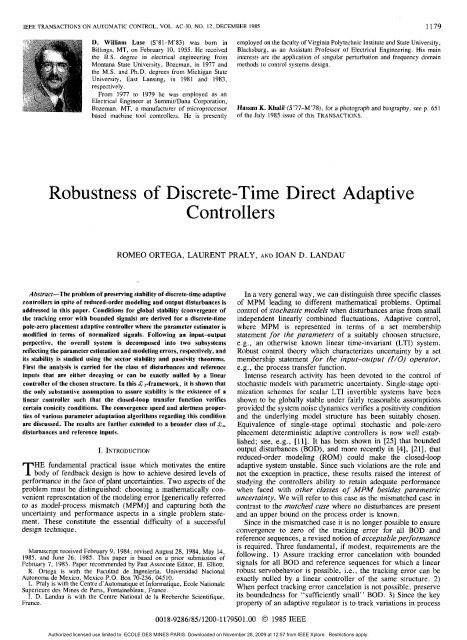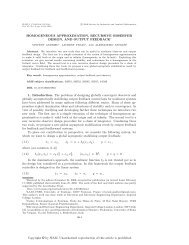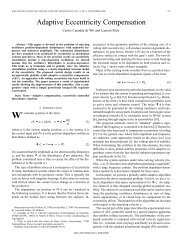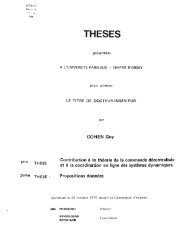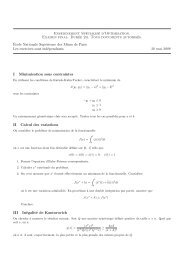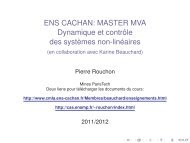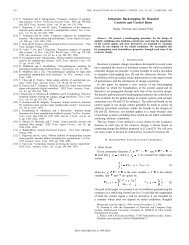Robustness of Discrete-Time Direct Adaptive Controllers - Centre ...
Robustness of Discrete-Time Direct Adaptive Controllers - Centre ...
Robustness of Discrete-Time Direct Adaptive Controllers - Centre ...
You also want an ePaper? Increase the reach of your titles
YUMPU automatically turns print PDFs into web optimized ePapers that Google loves.
IEEE TRANSACTIOKS ON AUTOMATIC CONTROL. VOL. AC-30, NO. 12, DECEMBER 1985 1179D. William Luse (S’81-M’83) was born in employed on the faculty <strong>of</strong> Virginia Polytechnic Institute and State University,Billings, MT. on February 10, 1955. He received Blacksburg, as an Assistant Pr<strong>of</strong>essor <strong>of</strong> Electrical Engineering. His mainthe B.S. degree in electrical engineering from interests are the application <strong>of</strong> singular perturbation and frequency domainMontana State Universit)., Bozeman, in 1977 and methods to control systems design.the M.S. and Ph.D. degrees from Michigan StateUniversity. East Lansing, in 1981 and 1983.respectively.From 1977 to 1979 he was employed as anElectrical Engineer at SummitIDana Corporation,Bozeman. MT, a manufacturer <strong>of</strong> microprocessor Hassan K. Khalil (S’77-M’78). for a photograph and biography, see p. 651based machine tool controllers. He is presently <strong>of</strong> the July 1985 issue <strong>of</strong> this TRANSACTIOKS.<strong>Robustness</strong> <strong>of</strong> <strong>Discrete</strong>-<strong>Time</strong> <strong>Direct</strong> <strong>Adaptive</strong>A<strong>Controllers</strong>ROMEO ORTEGA, LAURENT PRALY, AND IOAN D. LANDAUAbstract-The problem <strong>of</strong> preserving stability <strong>of</strong> discrete-time adaptive In a very general way, we can distinguish three specific classescontrollers in spite <strong>of</strong> reduced-order modeling and output disturbances is <strong>of</strong> MPM leading to different mathematical problems. Optimaladdressed in this paper. Conditions for global stability (convergence <strong>of</strong> control <strong>of</strong> stochastic models when disturbances arise from smallthe tracking error with bounded signals) are derived for a discrete-time independent linearly combined fluctuations. <strong>Adaptive</strong> control,pole-zero placement adaptive controller where the parameter estimator is where MPM is represented in terms <strong>of</strong> a set membershipmodified in terms <strong>of</strong> normalized signals. Following an input-output statement for the parameters <strong>of</strong> a suitably choosen structure,perpective, the overall system is decomposed into two subsystems e.g., an otherwise known linear time-invariant (LTI) system.reflecting the parameter estimation and modeling errors, respectively, and Robust control theory which characterizes uncertainty by a setits stability is studied using the sector stability and passivity theorems. membership statement for the input-output (110) operator,First the analysis is carried for the class <strong>of</strong> disturbances and reference e.g., the process transfer function.inputs that are either decaying or can be exactly nulled by a linear Intense research activity has been devoted to the control <strong>of</strong>controller <strong>of</strong> the chosen structure. In this d: 2-framework, it is shown that stochastic models with parametric uncertainty. Single-stage optitheonly substantive assumption to assure stability is the existence <strong>of</strong> a mization schemes for scalar LTI invertible systems have beenlinear controller such that the closed-loop transfer function verifiescertain conicity conditions. The convergence speed and alertness propershownto be globally stable under fairly reasonable assumptionsprovided the system noise dynamics verifies a positivity conditionties <strong>of</strong> various parameter adaptation algorithms regarding this condition and the underlying model structure has been suitably chosen.are discussed. The results are further extended to a broader class <strong>of</strong> E, Equivalence <strong>of</strong> single-stage optimal stochastic and pole-zerodisturbances and reference inputs.placement deterministic adaptive controllers is now well established;see, e.g., [ll]. It has been shown in 1251 that boundedI. IKTRODUCTIOKoutput disturbances (BOD), and more recently in [4], [21], thatreduced-order modeling (ROM) could make the closed-loopHE fundamental practical issue which motivates the entire adaptive system unstable. Since such violations are the rule andT body <strong>of</strong> feedback design is how to achieve desired levels <strong>of</strong> not the exception in practice, these results raised the interest <strong>of</strong>performance in the face <strong>of</strong> plant uncertainties. Two aspects <strong>of</strong> the studying the controllers ability to retain adequate performanceproblem must be distinguished: choosing a mathematically con- when faced with other classes <strong>of</strong> MPM besides parametricvenient representation <strong>of</strong> the modeling error [generically referred uncertainty. We will refer to this case as the mismatched case into as model-process mismatch (MPM)] and capturing both the contrast to the matched case where no disturbances are presentuncertainty and performance aspects in a single problem state- and an upper bound on the process order is known.ment. These constitute the essential difficulty <strong>of</strong> a successful Since in the mismatched case it is no longer possible to ensuredesign technique.convergence to zero <strong>of</strong> the tracking error for all BOD andreference sequences, a revised notion <strong>of</strong> acceutable uerformanceis required. Three fundamental, if modest, requirements are theManuscript received February 9. 1983; revised August 28, 1984. May 14:1985, and J~~~ 26, 1985. This paper is based on a submission <strong>of</strong> l> Assure tracking cancelation with boundedFebruary 7, 1983. Paper recommended by Past .Associate Editor. H. Ellion. signals for all BOD and reference sequences for which a linearR. Onega is with the Facultad de Ingenieria, Universidad Nacional robust servobehavior is possible, i.e., the tracking error can beAutonoma de Mexico, Mexico P.O. Box 70-256. 03510.exactly nulled by a linear controller <strong>of</strong> the same structure. 2)L. haly is with the <strong>Centre</strong> d‘Automatique et Informatique. Ecole Nationale When perfect cancelation is not possible, preserveSuperieure des Mines de Paris, Fontainebleau, France.I. D. Landau is with the <strong>Centre</strong> National de la Recherche Scientifique. its boundedness for “sufficiently small” BOD. 3) Since the keyFrance. property <strong>of</strong> adaptive an is regulatortrack variations in process0018-9286/85/1200-1179$01.~ O 1985 IEEEAuthorized licensed use limited to: ECOLE DES MINES PARIS. Downloaded on November 28, 2009 at 12:57 from IEEE Xplore. Restrictions apply.
ORTEGA et ai.: DISCRETE-TIME DIRECT ADAPTIVE CONTROLLERS 1181subsystems: the parameter adaptation algorithm (PAA) and an this assumption simply states that the system may be stabilized byLTI subsystem independent <strong>of</strong> the parametric error.a linear regulator <strong>of</strong> the chosen structure. If eLS is empty the plantIn this section we will first define the MPM representation cannot be stabilized even when it is perfectly known.considered in the paper. A standard pole-zero placement adaptivecontroller is introduced later. Before proceeding to describe thePAA, which is left to Section 111, error equations suitable to therobust stability analysis are then established. Assuming linearstabilizability <strong>of</strong> the process, the stability problem <strong>of</strong> the adaptivecase is reduced to the analysis <strong>of</strong> a feedback arrangement aroundthe PAA; this arrangement is suitable to the application <strong>of</strong> I/Ostability theorems [2], [9], [17].C. Error EquationsCombining (2.5) with (2.1) and using (2.4)CYl=B6~@,-d+S,~,CUr=A0:4,-R.Jf.(2.6a)(2.6b)A. The PlantIt is assumed that the plant to be controlled is described byA(q-1)Y,=q-dB(q-1)U,+5, (2.1)where A, B are polynomials in q - I. A is monic, U,, Y,, 4, are theinput, output, and disturbance sequences: and d is known. Theorder <strong>of</strong> each polynomial and its coefficients are unknown and 5,is bounded, i.e., 6, E a,.Define$1 2 ($z-d-e.+)T4[-d 2 8T-dbl-d (2.7)where 8, is the difference behveen the actual parameters [see(2.3)] and a vector <strong>of</strong> stabilizing parameters. From (2.2), (2.3),(2.6), and (2.7) we see that the error model may be expressed aswheree,= -ki2+,+e; (2.8)B. The Controller StructureWe will pursue a pole-placement all-zero canceling objectivewith the desired closed-loop poles being the roots <strong>of</strong> a polynomialCR. Defining a filtered tracking errore, 4 C, Y, - w, (2.2)our objective is to ensure that e, tends to 0 as t tends to infinity.Choosing two integers ns and nR we use the regulator structure~~uu,=Wy;d-ff(Yfwhere 9, and R , are polynomial functions in q <strong>of</strong> degrees ns andnR, respectively, with time-varying coefficients and <strong>of</strong> is thereference signal assumed known d steps ahead. In compactnotation the control law may be written aswithWt+d=e:@f (2.3)61 & [Ut, Ut-,, Ur-ns; Yr, Yr-19 Yr-nRIT- (2.4)Before proceeding with the process reparameterization, let usintroduce the following stabilizability assumption that will justifythe choice <strong>of</strong> the regulator given above.Assumption A.1: Let S,, R, be polynomials <strong>of</strong> given ordersns, nR. Let p E (0, 1) be a scalar. Define the polynomialcoefficients vectorand the polynomial0 2 [so*, ST, .e., sfs,rg, r:,*- 9 ‘;RlTC 4 S,A +q-dR,B. (2.5)With these notations, we assume that there exists a nonempty setBLS defined aseLs 6 {e,Ew : c(q)#o, v qEC, lql>pliz)#Owhere n A ns + nR + 2. 0Remark 2.1: The set OLs defines the fixed gain regulatorswhich ensure that the systems closed-loop poles are within a disk<strong>of</strong> radius p where p is a designer chosen parameter to bedefined later. The elements <strong>of</strong> this set, which we will call thelinear stabilizing set, the corresponding polynomials and associatedsignals will be denoted with an asterisk. Notice that for p = 1e: 2 (Hz - l)w, + CR C-lS,,$, (2.9a)H2 gCRC-IB.The regressor vector can analogously be written aswherew, p c-’ [A, q-’A, e..,(2.9b)dr-d= - WI$r++:-d (2.10)6F-d 4 wlw,+ Wz(1qpA;(2.11a)q-dB, qd-’B, . . ., a-d-nsB] (2.1 lb)w2 2 C-l[-q- dR*, _q-d-lR *’ . . . , -q-d-n~R,;q-dS,, q-d-lS,,-.., q-d-”SS*]. (2.11c)Remark 2.2: Notice that in the matched case there exists S,and R, such that C, = CRB, see (2.5), so that H2 = 1.Furthermore, since E, = 0, then e:‘ = 0. It is reasonable to expectthat the stability conditions in the mismatched case will require“Hz close to 1” and “small” e,*. Our problem is to formalizethese notions and to provide conditions to ensure its verification.In Fig. 1 the complete error model is depicted. HI denotes arelation defined by the PAA. One important difference arises withrespect to the continuous-time error model developed in [lo],namely that defining $, in terms <strong>of</strong> the delayed signals [see (2.7)],allows us to obtain a transfer function Hz <strong>of</strong> relative degree zero,i.e., proper. This will prove to be <strong>of</strong> fundamental importance inthe analysis <strong>of</strong> the stability conditions implications.Remark 2.3: It is easy to show that H2 = c~y;/~,+d; thatis, H2 represents the transfer function <strong>of</strong> the process in closedloopwith a stabilizing regulator. e; and q5; are the correspondingtracking error and regressor signals for that linear scheme. Noticethat they can be interpreted as inputs to the error model [ 101 whichare bounded in view <strong>of</strong> Assumption A.l. Henceforth, theestablishment <strong>of</strong> tracking error convergence conditions for theoverall system reduces to ensuring stability for the feedbackinterconnection <strong>of</strong> the blocks HI, Hz. Boundedness <strong>of</strong> @, willfollow if the former conditions are +,-independent.III. THE PARAMETER ADAPTATION ALGORITHMSWe intend to obtain stability conditions in terms <strong>of</strong> conicbounds in the presence <strong>of</strong> MPM. In addition, we will attempt tosatisfy performance requirements. Our key technical device toAuthorized licensed use limited to: ECOLE DES MINES PARIS. Downloaded on November 28, 2009 at 12:57 from IEEE Xplore. Restrictions apply.
1182 IEEE TRANSACTIONS ON AUTOMATIC COh'TROL. VOL. AC-30, NO. 12, DECEMBER 198514Lproved for invertible systems [I31 by showing that A8, E Oe2.Similar results were obtained in [25], [26].The introduction <strong>of</strong> the CI posteriori error representation [6],[ 1 I] allows a clear-cut interpretation <strong>of</strong> the stability pro<strong>of</strong>s, eitherLyapunov or Popov based, available in the literature. Due to thestructure <strong>of</strong> the integral PAA it is easy to_spow that in the matchedcase e; as given in (3.2) is equal to TO, i$-d, the a posteriorierror. Since the operator H,:e: + is passive (for aconstant gain matrix), even for unbounded +,,-direct application<strong>of</strong> the passivity theorem leads tcthe stability <strong>of</strong> 8 '41-d. The pro<strong>of</strong>is completed by showing that 8:&d + 0 impfies e, + 0 withbounded 4,. A similar procedure will be required below when wewill seek to prove stability <strong>of</strong> the adaptive scheme from thestability <strong>of</strong> the normalized signals.Remark 3.1: It can also be shown that when d > 1 aninterlaced version <strong>of</strong> (3.1) avoids the necessity <strong>of</strong> using theaugmented error in (3.2) since for that schemestudy the feedback interconnection is the conic sector stabilitytheorem [17] (see also [2]). It is required then to choose a PAAsuch that sector conditions may be established for the relationHI:e, --f $,.It will be shown below that to obtain +,-independent propertiesfor the PAA (see Remark 2.3) normalization <strong>of</strong> e, and 4, arecompulsory. In the following (:) will be used to denotenormalized variables and corresponding operators and aredefined as:2 p,-l'2+l-d, g, ~p,-"2e,; $ , = p;"'$, (3.0a)Hi- G * P, -l/2Hi,,1/2 .]; i= 1, 2. (3.0b)The normalization factor p, is introduced in Section V.To gain some insight into the problem <strong>of</strong> the selection <strong>of</strong> thePAA we will consider first the approaches and motivations <strong>of</strong> thematched case, that is when no ROM or BOD are present. A class<strong>of</strong> PAA for which suitable 110 properties have been established islater presented and its properties stated and proved.A. The Matched CaseMost adaptive schemes reported in the literature use an integralPAA <strong>of</strong> the form8,=8,-1+F,4,-de; (3.1)where F, is a time-varying matrix (the matrix gain) and e; is anestimate <strong>of</strong> the prediction error. The increasing complexity <strong>of</strong> thetreated cases required increasing information fed through e; intothe PAA. Therefore, the choice <strong>of</strong> e; may be thought <strong>of</strong> asreflecting the evolution <strong>of</strong> the adaptive control theory. It wasinitially taken equal to the tracking error to solve the unitary delaycase. Later it was shown that using this same error, a physicallyrealizable globally stab!e solution was still possible for = 2, byproper replacement <strong>of</strong> 8, by the multiplier operator PL(8,). I. Thislast modification was required to ensure the positive real condition<strong>of</strong> the error model. The ingenious inclusion <strong>of</strong> the augmentederror model allowed pro<strong>of</strong> <strong>of</strong> convergence <strong>of</strong> the tracking error bytakingB. PAA Sector ConditionsGiven our objective <strong>of</strong> uniform asymptotic stability we disregardproportional components in the PAA. In addition, gaindecreasing PAA are discarded to preserve the alertness <strong>of</strong> theadaptive scheme. Extrapolating from current usage we considerintegral interlaced PAA <strong>of</strong> the formwhere 5 takes one <strong>of</strong> the following forms.1) Constant gain (CG) PAA: 5 is a scalar5 2 f>O. (3.4a)2) Regularized least squares (RLS) PAA: 5 is a time-varyingmatrix5 2 F, (3 Ab)where (see [24] for further details)and X, < XI, X are strictly positive scalars.The eigenvalues <strong>of</strong> F, are all contained in the chosen interval[b, All.Equations (3.3) and (3.4) define an operator RI:P, + 6, (seeFig. 2). Besides this operator we will con_sider for th_e RLS/PAA,its exponentially weighted counterpart HY:Cp + $; where thesuperscript a denotesx; P a'X, : a>o.The I/O properties <strong>of</strong> the two operators are summarized in thefollowing lemma. Similar results were obtained earlier in [7],[ 141, [ 151, [24]. Notice that A;. = A, when a = 1.Lemma 3.1 (I/O Properties <strong>of</strong> the PAA):1) CG/PAA: If 5 is given by (3.4a), then+(cR YI-~T-I'#'I-~)/(~ +d':-dFrdl-d). (3.2)However, this new form <strong>of</strong> e; posed the new stability problem <strong>of</strong>ensuring boundedness <strong>of</strong> the auxiliary signal, which was laterfor all 6CG such that' This section's discussion, although restricted to discrete-time systems. isfurther simplified b] choosing the following structure for the operator:PL:Pr(!,) 2 qded- (see [13]) so that the operator retains the basic concepts<strong>of</strong> contmuous and hybrid schemes.2) RLS/PAA: If 3 is given by (3.4b). (3.4c), thenis outside CONE ( - 1, v'l - cRLS)Authorized licensed use limited to: ECOLE DES MINES PARIS. Downloaded on November 28, 2009 at 12:57 from IEEE Xplore. Restrictions apply.
ORTEGA et a[.: DISCRETETIME DIRECT ADAPTIVE CONTROLLERS 1183for CY verifyingand all SRU satisfying(3.7)Pro<strong>of</strong>: The pro<strong>of</strong> is given in two parts. The passivityproperty for the CG/PAA is first established. The conic sector forthe RLSlPAA is later derived.1) Consider the quadratic functionVI p p -T ' f -I$ Idirect manipulation <strong>of</strong> (3.3) and (3.4a) givesIt can be readily seen that1-VI- vr-d=$[(?[+- $:-df&l-d((?[)'.2which completes the first part <strong>of</strong> the pro<strong>of</strong>.2) Let the matrix Fr' and the scalars VI, VI' be defined asvanish. It is exactly at this point that our result differs from [5],[81, U51, WI.Remark 3.3: Another interesting property for our study wouldbe to have CY > 1 in (3.6). Clearly from (3.4~) we haveTherefore, in any caseF,rF;..cy2 1. (3.10)In some circumstances, the stronger grbperty "CY > 1" is alsosatisfied. In the Appendjx we show that, in the case d = 1, this isachieved at least for persistently spanning in the followingsense: there exist 0 < fl < 1, E > 0, No such that:N1=Ofi,'8-r&j:>~i tl NZNo. (3.1 1)Unfortunately this is a signal-dependent condition. However, it isusually satisfied for X lacge enough (slow adaptation) and for allperiod <strong>of</strong> time such that 8, E eLs provided the reference input ispersistently exciting.IV. STABILITY OF THE NORMALIZED ERROR MODELSZ and $,-stability results for the normalized system are givenbelow. Discussion on the stability conditions is deferred to thefollowing section, where stability <strong>of</strong> the adaptively controlledsystem is derived from the stability <strong>of</strong> the normalized error model.A. C2-StabilityCombining Lemma 3.1 and the sector stability theorem we getthe following Cz result for the normalized system.Lemma 4.1: Consider the feedback interconnectionWe have (see the Appendix)Vl:sh max (F;'F;) . V;and after some algebra (see [30] for example).V; - Vt-d=($t+cl)2-xc; .x+6;-dFr-&dNow from (3.4c), (3.6) it follows that:Hence,ffMk mFiX (F['F;)Sl, 6:-dF[-d&c-d5hld:_d~l-d.Summing from 0 to N leads to the resultRemark 3.2: From (3.5), (3.7) we see that the PAA'sproperties are critically dependent on the boundedness <strong>of</strong> 6,. Thisindicates that the no-rmalization factor pl in (3.0) should ensure afinite $,-norm for 6,. We will assume from now on that pl is suchthatll&rllm51. (3.9)A sequence p, giving this property will be presented in Section V.WithA(3.9), the ' radius <strong>of</strong> the cone for the RLS/PAA does notlJ[=H]e'[- _PI= -H2$,+C;.If H 2 is strictly inside a & CONE (CA, RA), where(CA,for anythen(4.la)(4.lb)(1/&~, l/Scc) for the CG/PAA (4.2a)(l/&LS, v'l - cRLs/cRRLs) for thex16 ~ f and ~ 26RU>-X+h,el, $,E&for dl PTEX~.RLS/PAA (4.2b)(4.3)Pro<strong>of</strong>: This is a straightforward application <strong>of</strong> [17, Theorem2a p. 2341. E.B. $,-StabilityThe 2, extension <strong>of</strong> the previous result using the RLS/PAAfollows below.Lemma 4.2: Consider the feedback system (4.1) for the RLYPAA. Assume pr is bounded awayfrom zero. Under theseconditions, ifH; 2 CY'^^[^-'] . is strictly inside Q [with @. as in (4.2b)lwith CY > 1 satisfying (3.b), then there exists a scalar K2 such thatAuthorized licensed use limited to: ECOLE DES MINES PARIS. Downloaded on November 28, 2009 at 12:57 from IEEE Xplore. Restrictions apply.
1 I84 IEEE TRAl(e,*)"Pro<strong>of</strong>: &stability <strong>of</strong> the map --* $; (see Fig. 2) isensured from Lemma 3.1 and the sector stability theorem. That is,3 K2 < 03 such thatlllt~l,t...K*ll(et)~ll;~, v NrO. (4.4)VSACTIONS ON AUTOMATIC CONTROL, VOL. AC-30. NO. 12. DECEMBER 1985Notice that\~$~]~+(O1~~$:v)~ (4.5)Fig. 2.andsince CY > 1. Combining (4.4)-(4.6) we can conclude thatuniformly in Nwhere(4.7)p minp,>O. ti (4.8)Remark 4. I: The same types <strong>of</strong> arguments were used in [23] toprove the boundedness <strong>of</strong> e, assuming a priori constraints in theregressor vector.IVI. MAIN RESULTSIn this section we will determine the conditions under whichstability is preserved for the plant (2.1) in closed loop with thetime-varying regulator (2.3) and adaptive law (3.3). (3.4). Forthis purpose we will introduce the following normalization factor:Pr=w-l+max (I+r-d12, P), P>O, PE(O, 1) (5.1)which together with (3.0) completes the description <strong>of</strong> the PAA.Remark 5.1: This type <strong>of</strong> multiplier was introduced in [25].and its importance for robustness established in [24], [30]. p is asmall positive constant that defines a lower bound to p,. Thechoice <strong>of</strong> the time constant ,u will prove to be a compromisebetween PAA alertness and robustness.The problem is solved by analyzing the error models depictedin Figs. 1 and 2. It should be recalled (see Remark 2.3) that underthe stabilizability Assumption A.l the key point is provingstability <strong>of</strong> $[ [see (2.8). (2. IO)]. The pro<strong>of</strong> proceeds as follows.First we prove using the Bellman-Gronwall lemma that &-stability <strong>of</strong> $I (given by Lemma 4.1) implies 3, E 2,. This in itsturn assures that the regressor vector is bounded. As a consequence,the normalizing factor p, is bounded and proceeding fromthe multiplier theory &-stability <strong>of</strong> the normalized error modelimplies &-stability <strong>of</strong> the adaptive system. For the &,-stabilitypro<strong>of</strong>, boundedness <strong>of</strong> $,, as shown in Lemma 4.2, is used toestablish boundedness <strong>of</strong> $,.The stability conditions derived in Lema 4.1 and 4.2 aretranslated in terms <strong>of</strong> the designer chosen parameters (os, n,, C,,p) and the MPM (Hz, t,).A. &-StabilityTheorem 5. I: Consider $, given in (3.0), (5.1) and 41 as in(2.10). (2.1 1). Under these conditions if Assumption A.l <strong>of</strong>Section 11-B is verified, then$IE.e2=)$r€Oe.r.Pro<strong>of</strong>: Define the exponentially weighted signals [9. p. 25 1 Jwhere we have used the fact that PO, p , w, { $,}zo, {, Ebound them by 6K1p -.v.Applying the Bellman-Gronwall lemma to (5.6)which may also be written as,=oto. (5.7)The term inside the brackets is smaller than 1 and the series isconvergent, therefore, we can conclude that $, E C,. 0Corollary 5. I: If $, E 22, a,, 4, E Sm and A. 1 holds, then 4,E C , and consequently p, E 2,.Pro<strong>of</strong>: Follows immediately from Theorem 5.1 ~ (2. lo), and(5.1). 0The following lemma will help us to find the coniciryconditions over Hz ensuring the ones required in Lemma 4.1.Lemma 5.1: Let us consider the operator H: y, + q,. Ifti[(p''2q) - I ] is inside the CONE (C, R), then H 2 p;I'*Hp:/'Authorized licensed use limited to: ECOLE DES MINES PARIS. Downloaded on November 28, 2009 at 12:57 from IEEE Xplore. Restrictions apply.
ORTEGA el ai.: DISCRETE-TIME DIRECT .4DAF'TIVE CONTROLLERS1185(i.e., H:y, + VI) with pr as in (5.1) is inside the same CONE (C,R) . Pro<strong>of</strong>: See also [ 141. DefineTaking the sum22I =(rr -- (RrlIY2, ~ (~/-C~,)~-((R~l)~=p;~Z/.2 ",=E plPl-lp-l~/=P:%+l -16 .v .I'P.v+ I P-lzlf=o /=0 ,=oThe pro<strong>of</strong> is completed noting that plp;' is decreasing sincep-(l+I)Pr+l=p-IpI+p--I~+I)and the implicationsH[(p"'g)-']€CONE (C, R)-N/=0max [~,l+~-d+ll']1[~~"z~r-cp-"2~~l)2-(Rp-"'yr)2]
1186 IEEE TRANSACTIONS ON AUTOMATIC CONTROL, VOL. AC-30. NO. 12, DECEMBER 1985with a normalized estimator has been presented. Systems witharbitrary relative degree may be considered (in contrast to thecontinuous-time robustness studies [lo], [21]) however we requirethe latter to be known. The stability conditions reduce to theexistence <strong>of</strong> a linear regulator (<strong>of</strong> the chosen structure) such that:1) +e closed-loop tracking transfer function "approaches" thedesired closed-loop behavior; 2) "good" disturbance rejectionproperties are attainable. Increasing the speed <strong>of</strong> adaptationrenders these requirements more stringent.Although the two previous conditions preserve the essence <strong>of</strong>the usual performance (in the sense <strong>of</strong> pole-placement) anddisturbance rejection design objectives, they unfortunately do not<strong>of</strong>fer any engineering design guidelines. The primary culprit hereis the notion <strong>of</strong> transfer function vicinity (as stated in 1) above)which requires that the phase:shift between the attainable and thedesired transfer functions should not exceed go", at all frequencies.This has been referred to in the literature as the positive realcondition (<strong>of</strong> Hz).One fundamental difference arises at this point betweencontinuous and discrete-lime robustness results. In the latter theassumption <strong>of</strong> known delay permits us to obtain a parametrizationwhere H2 has the relative degree zero. In terms <strong>of</strong> the Nyquistlocus this implies that for all stably invertible processes the overallphase shift contribution is zero, i.e., the locus starts and ends inthe same side <strong>of</strong> the complex plane. Therefore, since phasemodification (usually phase lead) is only required over a limitedfrequency range. it will always be possible by proper filtering tosatisfy the positivity condition. TWO important questions remainhowever to be solved. How should we incorporate the availableprior knowledge to convert the conicity conditions into tests forrobustness? The second question is more disturbing. How shouldwe deal with nonstably invertible process, very likely to appear ina discrete-time context?APPENDIXFrom (3.4c), (3.8), (3.9). d = 1, we have the followingproperty.Lemma: If there exist E > 0 and No such thatwithNTherefore XI F;l - I is positive definite for any finite t.ii) F,' has a symmetric positive definite square root Fl'1/2 andwe havewe haveThis proves that:y = Fr' '/?xx TF; 'xmax-=A max F; IF;x xTFr'-'xiii) If A is a symmetric positive definite matrix, thenxTAx~(1 +X max A)xTA((I+A)-Ix, v x.This is proved by noticing that we can choose a symmetricpositive definite square root A which commutes with (I +A) -I. Then withThe inequality becomes simply=A I/2 X.yTy
ORTEGA el al.: DISCRETE-TIME DIRECT ADAPTIVE CONTROLLERSThen with fact iii), it follows that (in the sense <strong>of</strong> quadratic form)This impliesThe conclusion follows from the assumption and the prop6rties <strong>of</strong>Gr. 0ACKNOWLEDGMENTThe authors are grateful to C. E. Rohrs and the anonymousreviewers for many valuable suggestions.r11r21I31r41r61REFERENCESJ. C. Doyle and G. Stein, “Multivariable feedback design: Conceptsfor a modern/classical synthesis,” ZEEE Trans. Automat. Contr.,vol. AC-26, pp. 4-17, Feb. 1981.M. C. Safonov, Stability <strong>Robustness</strong> <strong>of</strong> Multivariable FeedbackSystems. Cambridge, MA: M.I.T. Press, 1980.R. L. Kosut, “Analysis <strong>of</strong> performance robustness for uncertainmultivariable systems,” in Proc. 21st Conf. Decision Contr.,Orlando, FL, Dec. 8-10, 1982.C. E. Rohrs, “<strong>Adaptive</strong> control in the presence <strong>of</strong> unmodeleddynamics,” Mass. Inst. Technol., Cambridge, MA, Rep. LIDS-TH-1254, Nov. 1982.R. Ortega and I. Landau, “On the design <strong>of</strong> robustly performingadaptive controllers for partially modeled system,’’ in Proc. 22ndZEEE Conf. Decision Contr., San Antonio, TX, Dec. 14-16, 1983.I. D. Landau and H. M. Silveira, “A stability theorem withapplications to adaptive control,” ZEEE Trans. Automat. Contr.,VOI. AC-24, pp. 305-311, 1979.P. J. Gawthrop, “On the stability and convergence <strong>of</strong> a self-tuningcontroller,” Int. J. Contr., vol. 31, pp. 973-998, 1980.P. J. Gawthrop and K. W. Lim, “<strong>Robustness</strong> <strong>of</strong> self-tuning controllers,”IEEE Proc., vol. 129, pp. 21-29, Jan. 1982.C. A. Desoer and M. Vidyasagar, Feedback Systems: Input-OutputProperties New York: Academic, 1975.R. L. Kosut and B. Friedlander, “Performance robustness properties <strong>of</strong>adaptive control systems,” in Proc. 21sf Conf. Decision Contr.,Orlando, FL, Dec. 8-10, 1982; also in “Robust adaptive controlconditions for global stability,” in IEEE Trans. Automat. Contr.,vol. AC-30, no. 7, pp. 610-624, July 1985.I. D. Landau, “MRAC and stochastic STR-a unified approach,”Trans. ASME J. Dynam. Syst. Meas. Contr., Dec. 1981.R. Ortega, “Assessment <strong>of</strong> stability robustness for adaptive controllers,”IEEE Trans. Automat. Contr., vol. AC-28, p. 1106, 1983.K. S. Narendra, “Stable adaptive controller design: pro<strong>of</strong> <strong>of</strong> stability,”ZEEE Trans. Automat. Contr., vol. AC-25, June 1980.P. J. Gawthrop, “Some properties <strong>of</strong> discrete adaptive controllers,” inSelf-Tuning & <strong>Adaptive</strong> Control, Harris and Billings. Eds. NewYork: Peregrinus, 1981.R. Ortega and I. D. Landau, “On the MPM tolerance <strong>of</strong> various PAA:A sectoricity approach,” ZFAC WorkshoD AdaDt. - Syst., . SanFrancisco, CA, jine 20-22, 1983.S. Shah, “Internal model adaptive control,” Stanford Univ., Stanford,CA, Rep. 63-81-2, Aug. 1981.G. Zames, “On the I/O stability <strong>of</strong> time varying nonlinear feed-backsystems Part I & 11,” ZEEE Trans. Automat. Contr., vol. AC-11,1366.[18] B. Peterson and K. S. Narendra, “Bounded Error adaptive control,”ZEEE Trans. Automat. Contr., vol. AC-27, Dec. 1982.[I91 G. Kreisselmeier and K. S. Narendra, “Stable MRAC in the presence<strong>of</strong> bounded disturbances,” IEEE Trans. Automat. Confr., vol. AC-27, Dec. 1982.[20] M. J. Balas and C. R. Johnson, “<strong>Adaptive</strong> identification and controlusing reduced-order models,’’ Yale Adapt. Confr. Conf., 1981.[21] P. Ioannou and P. W. Kokotovic, <strong>Adaptive</strong> Systems with ReducedModels. New York: Springer-Verlag, 1983.[22] R. Kosut and C. Johnson, “An input-output view <strong>of</strong> robustness inadaptive control,” Automatica, (Special Issue on <strong>Adaptive</strong> Control),1984.[3 111187K. W. Lim, “<strong>Robustness</strong> <strong>of</strong> self-tuning controllers,” Ph.D. dissertation,Hertford Coll., Oxford, England, 1982.L. Praly, “<strong>Robustness</strong> <strong>of</strong> model reference adaptive control,” in Proc.3rd Yale Workshop, New Haven, CT, June 15-17, 1983.B. Egardt, Stability <strong>of</strong> <strong>Adaptive</strong> <strong>Controllers</strong>. New York: Springer-Verlag, 1979.G. Goodwin, P. Ramadge and P. Caines, “<strong>Discrete</strong> time multivariableadaptive control,” ZEEE Trans. Automat. Contr., vol. AC-25, June1980.T. Hagglund, New Estimation Techniques for <strong>Adaptive</strong> Control.Coden: LUTFD2/(TFRT-1025)/1-20/1983. Lund University.L. Praly, “Commande adaptive indirecte multivariable,” Coll; Nat.du CNRS., Belle IIe, Sept. 1982.-, “Robust MRAC: Stability analysis,” in Proc. 23rd ZEEEConf. Decision Contr., Dec. 1984.-, “<strong>Robustness</strong> <strong>of</strong> mdlrect adaptive control based on pole placementdesign,” in Proc. ZFAC Workshop on <strong>Adaptive</strong> Syst. inContr. and Signal Processing., June 1983.R. Ortega, “<strong>Robustness</strong> enhancement <strong>of</strong> adaptive controllers byincorporation <strong>of</strong> process apriori knowledge,” Syst. Contr. Lett., vol.4, pp. 135-141, May 1984; see also “Correction,” ibid. vol. 4, Oct.1984.Romeo Ortega was born in Mexico, on March 12,1954. He received the B.S. degree in mechanicaland .electrical engineering from the NationalUniversity <strong>of</strong> Mexico in 1975, the M.on E. degree(with honors) in control theory from the LeningradPolytechnical Institute, USSR, and the “Doctoratd’Etat-es-Sciences” degree from the PolytechnicalInstitute <strong>of</strong> Grenoble, Grenoble, France.He has held teaching and research positions at theNational University and Polytechnical Institute <strong>of</strong>Mexico. He is currently a Pr<strong>of</strong>essor in the Faculty<strong>of</strong> Engineering, Nation al University <strong>of</strong> Mexico. His main research interestsare in the development <strong>of</strong> analysis and design techniques for reliable controlsystems.Laurent Praly was born in 1954. He graduatedfrom Ecole Nationale Superieure des Mines deParis, Paris, France, in 1976.After working as Engineer in a private laboratoryfor three years, in 1980 he joined the <strong>Centre</strong>d’Automatique et Informatique, Ecole NationaleSuperieure des Mines de Paris, Fontainebleau,France. From July 1984 to June 1985, he spent asabbatical year as Visiting Assistant Pr<strong>of</strong>essor in theDepartment <strong>of</strong> Electrical and ComputerEngineering, University <strong>of</strong> Illinois,Urbana-Champaign. H is main interest is in automatic control withcontribution to adaptive systems.Ioan D. Landau received the Docteur-es-SciencesPhysiques degree from the University <strong>of</strong> Grenoble,Grenoble, France.He was an Associate Pr<strong>of</strong>essor at the InstitutNational Poytechnique de Grenoble from 1973 to1976 and a Senior Post-Doctoral ResearchAssociate at NASA-Ames Research Center from1971 to 1972. At present he is Research <strong>Direct</strong>or atthe <strong>Centre</strong> National de la Recherche Scientifique(C.N.R.S.). He is also <strong>Direct</strong>or <strong>of</strong> a nationalcoordinated research group at the Laboratoirede’Automatique, Institut National Polytechnique de Grenoble. He is theauthor <strong>of</strong> the book. <strong>Adaptive</strong> Control-The Model Reference Approach(New York: Marcel Dekker, 1979) and coauthor (with M. Tomizuka) <strong>of</strong> thebook <strong>Adaptive</strong> Control-Theory and Practice in Japanese (Ohm, 1981).Dr. Landau is the Chairman <strong>of</strong> the I.F.A.C. Working Group on <strong>Adaptive</strong>Systems in Control and Signal Processing. He received the Great Gold Medalat the Invention Exhibition, Vienna in 1968, the C.N.R.S. Silver Medal in1982 and the “Best Review Paper Award (1981-1984) for his paper “Modelreference adaptive controllers and stochastic self-tuning regulators-A unifiedapproach” published in the ASME Journal <strong>of</strong> Dynamical SystemsMeasurement and Control.Authorized licensed use limited to: ECOLE DES MINES PARIS. Downloaded on November 28, 2009 at 12:57 from IEEE Xplore. Restrictions apply.


